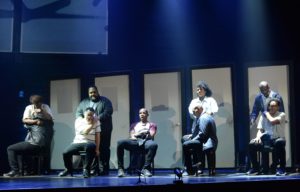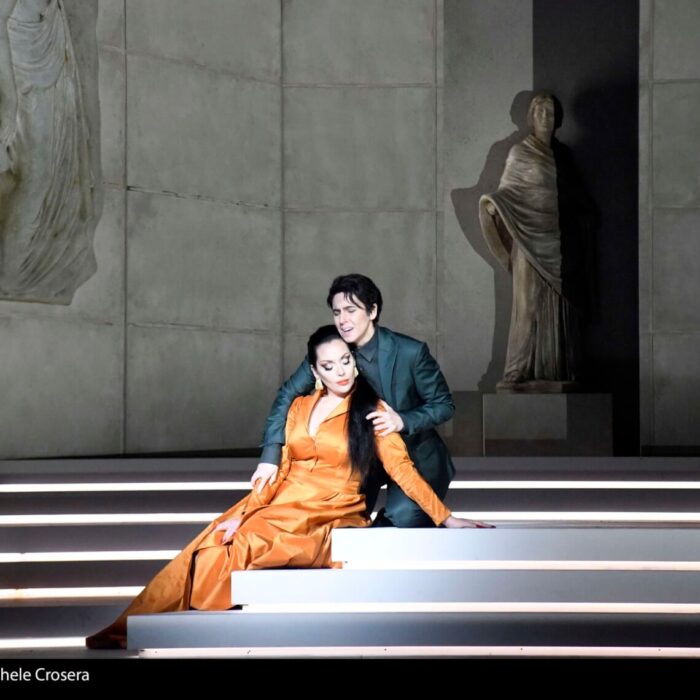
Long Beach Opera 2018-19 Review: The Central Park Five
A Powerful Work That Shines A Spotlight on An Important Event
By Gordon Williams(photo: Keith Ian Polakoff)
From the outset, let me say that Anthony Davis and Richard Wesley’s “The Central Park Five” is a powerful experience.
I’ve said elsewhere that impressive new operas are created out of U.S. current affairs because U.S. current affairs play out on an operatic scale. Such is the case with this account of the trial and later exoneration of five young men who became known as the Central Park Five – an event in recent history whose operatic dramatization was premiered last week in San Pedro’s Grand Warner Theatre by Long Beach Opera.
The Event
The story of the Central Park Five traverses huge emotional territory. In 1989, five young men – as young as 14 – were accused of raping a jogger in New York’s Central Park on the night of April, 19th. The five confessed – after apparently having been questioned for hours without legal representation, and in some cases without relief or the accompaniment of their parents. They later retracted their confessions. From what I’ve read, those statements contradicted each other (and DNA evidence excluded the accused, according to a PBS account quoted in the program booklet), but the confessions were allowed to stand as evidence, and the “five” accused were found guilty and served custodial terms ranging from 6-13 years. One of the accused, Korey Wise (16), was sent to an adult prison.
The “five” had their sentences vacated in 2002. A separate individual Matias Reyes who had left DNA at the scene confessed to the crime in 2001, and, in 2014, New York City, under the administration of Mayor Bill de Blasio, paid the “five” $41 million in compensation. (In 2016 the state of New York settled a further claim, paying $3.9 million.)
The case had racial overtones. Four of the accused (Antron McCray, Yusef Salaam, Kevin Richardson, and Korey Wise) were African-American, a fifth (Raymond Santana) was Hispanic. The media rushed swiftly to judgement, and, prior to the trial, real-estate magnate, Donald Trump took out full-page ads in New York newspapers calling for the return of the death penalty. The “five” were alleged to have been members of a gang of up to 30 youths menacing people in Central Park that night (and there were youths menacing people and there were assaults and they were in the park). But prior to the case the “five” were not necessarily tight. The term “Central Park Five” created an impression of gang-menace. Ava DuVernay’s recent Netflix series – “When They See Us” – portrays the City’s and media’s rush to judgement about the “five” through language that escalates from “witnesses” to “suspects” to “terrorizing” to “animals.”
An Operatic Take
But that’s a TV dramatization. How does Anthony Davis and Richard Wesley’s “The Central Park Five” work as an opera?
It goes deep – partially because we’re sitting in a theater hearing the theatrical telling of a story that’s in our news, about which many of us have views. But, also, because it’s well-told.
Much of the credit for that should go to librettist, Richard Wesley, an associate professor of playwriting and screenwriting at NYU’s Tisch School of the Arts, whose sound dramatic scheme set up strong momentum and a sense of “justice crying-out to be restored” even though, as a libretto, written with the expectation of musical expansion, it necessarily excluded the sort of evidentiary detail you can include in a wordier sort of drama. I must say I found myself, a number of times, writing on my notepad in the dark: “What will happen now?” – as if I didn’t already know the bare bones of the story. That’s impressive!
I admired the sequencing of the various ensembles – the groupings of parents, the “five,” the trios, duets. This really was operatic form being used to make telling points. A trio comprising Donald Trump (Thomas Segen), the District Attorney (not named, but played by Jessica Mamey), and Zeffin Quinn Hollis as a character called The Masque (at this point playing a seasoned detective)? What does this say about the prosecution of this issue? “The Central Park Five” was an ensemble piece well-served by its strong cast.
Composer Anthony Davis made great use of the opportunity of having five male protagonists by banding-together the accused as if to evoke a tradition of vocal quintets, going back to gospel. Some of the most musically-satisfying moments in the opera were the ensembles of bass-baritone Derrell Acon (McCray), bass-baritone Cedric Berry (Salaam), tenor Orson Van Gay (Santana), tenor Nathan Granner (Wise) and tenor Bernard Holcomb (Richardson). I actually hoped that more of the music might reach the profile of fully-fledged numbers after hearing standout moments such as “Harlem is my home.” But if I have any misgiving here it was that it took me a while to become fully conscious of the five as individuals (probably not until the courtroom scene where they were all named). That may say something about my deficiency as an audience-member, and I could have matched publicity shots in the printed program with singers’ names of course, but without reading the program it took me some time separating individuals from “the Five.” Other characters seem to have been more individualized – even the other ensemble grouping of the parents (bass-baritone Babatunde Akinboboye, tenor Ashley Faatoalia, soprano Joelle Lamarre and mezzo Lindsay Patterson), with its clear subdivisions of, say, the mothers.
In a pre-concert talk, composer Anthony Davis talked of how he wants his music to make the listener feel as if they’re always on a precipice. His score for “The Central Park Five” underlined that sense of “what next?” I gained from Wesley’s libretto. There is a hot spirit to Davis’s music – here nicely maintained by conductor Leslie Dunner – and I do think Davis is one classical composer who successfully leaves space for a jazz feel to really flourish. During musical interludes, I found myself tapping my foot, such was the music’s wonderful energy (though admittedly, it was not a foot-tapping sort of show).
I did notice a persistent shape to Davis’s vocal lines. As best I can describe it: a run-up to sustained notes on important words and then contraction of remaining words to fit into a phrase (eg. “givethemwhattheywant”). Does Davis write this way, rather than be bound by metrical strictness in the libretto, in order to guarantee improvisational freedom in the orchestral pit? But I felt that more metrical song might have sharpened the effect on occasion. If, for example, the District Attorney’s phrase beginning “Remember the victim” had evolved into more of a conventional tune, the sentiment might have had more nuance – and maybe greater irony, given the creators’ portrayal of her lack of concern for the “five” who were victims of a rush to judgement. (The rape victim in real-life was Trisha Meili.)
On the other hand, I have a definite imprint of Davis’s music in my head and I noticed and noted-down and can remember so many of the lines. The transcript-like nature of some of the libretto made the work hair-raisingly real. Perhaps the most moving scene for me, in terms of a feeling of authenticity, was that between Babatunde Akinboboye doubling as Matias Reyes and Nathan Granner as Korey Wise. By the way, I loved the use of Earl Howard’s Kurzweil and the sense of being enveloped by sound coming from the back of the theater.
Effective Presentation
“The Central Park Five” was given an incredibly effective presentation by Long Beach Opera’s Artistic and General Director Andreas Mitisek and designers Dan Weingarten (Lighting) and Earl Howard (Sound). I would argue that opening Act 2 with Donald Trump sitting on a golden toilet was a mis-step. It got a bit of a laugh, but the guy is deserving of a serious critique (placing that ad before the trial) and why speak only to those who will already agree with you? But for the most part, the production was serious and unflinching. Doors and screens were used most effectively, as, for example, when the District Attorney walked through door after door browbeating the five isolated accused into confession (another moment, admittedly, where the “five” were individualized).
I had been wondering how Davis and Wesley would finish the work. I wrote on my notepaper: “Will they editorialize?” Actually, the ending was quite sober and all the more powerful for it. “Every day is a struggle,” sang the “five” and then, in almost an anthem, “The world is ours. I kept my faith,” nicely capping off the First Act’s sense of generalized alienation: “They tell us in school how big the world is, but that world’s not ours.” Then toward the end, the cast turned to a back-projection of more recent headlines underscoring the idea that we should remember black lives matter.
I note that this is an opera review where I’ve been grappling with social issues rather than evaluating portamento or coloratura. I also know that from now on, from this experience and DuVernay’s mini-series, I will remember the names of the “Central Park Five.”
There’s something extremely moving about sitting in an opera like this with people who have a stake in the story and even an audience-member sporting a T-shirt emblazoned with the names of each of the accused. “How was the opera?” asked the guy behind the counter at the Sacred Grounds café next door after the performance. “Fantastic!” said his two customers, clearly profoundly moved. On TV, presidential candidate Pete Buttigieg was shown facing a Town Hall crowd, angry about the recent shooting of Eric Logan, a middle-aged black man by police in South Bend, Indiana where Buttigieg is mayor.


